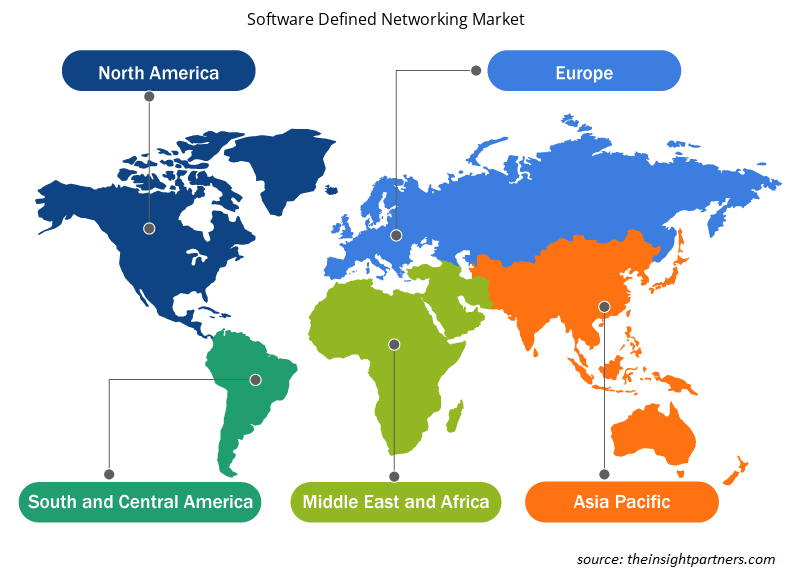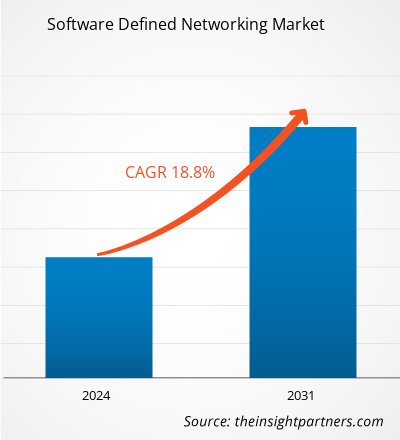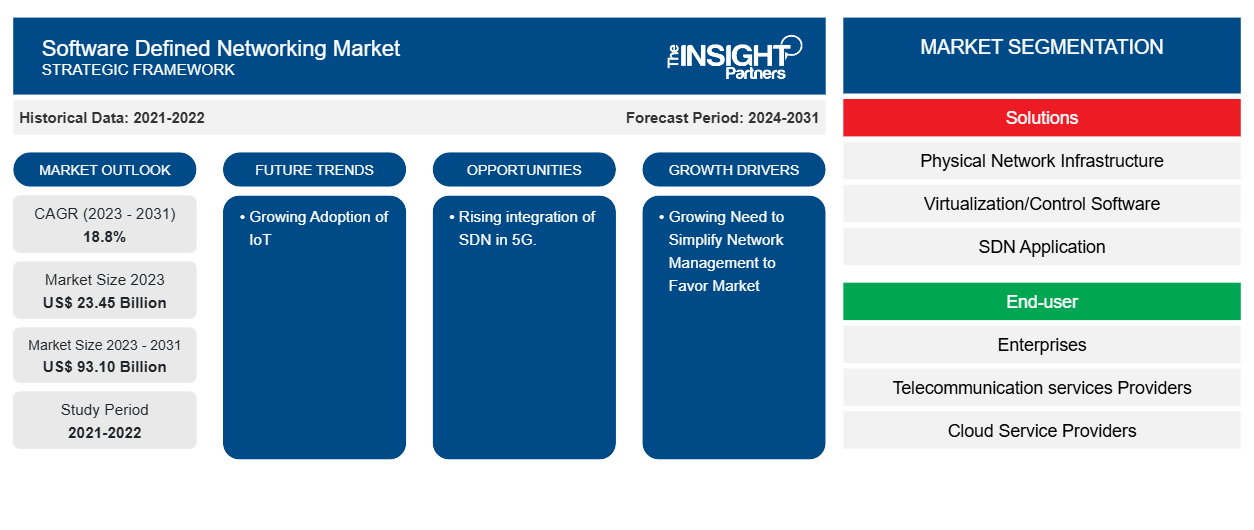Se proyecta que el tamaño del mercado de redes definidas por software alcance los 93.100 millones de dólares en 2031, frente a los 23.450 millones de dólares en 2023. Se espera que el mercado registre una CAGR del 18,8 % entre 2023 y 2031. Es probable que la creciente necesidad de simplificar la gestión de la red y la creciente implementación de SDN para 5G sigan siendo tendencias clave del mercado de redes definidas por software.
Análisis del mercado de redes definidas por software
El mercado de redes definidas por software está creciendo a un ritmo rápido y está impulsando el crecimiento del mercado a medida que las organizaciones de TI están cambiando rápidamente hacia la tecnología de la nube. Las empresas y entidades de TI tienen los beneficios asociados con los roles y eventos a nivel de aplicación para la eficiencia funcional y la resiliencia. Esto consiste en la automatización de servicios de red, la integración en la nube y los servicios de automatización híbridos. Actualmente, varias empresas están generando aplicaciones de servicios de red para software para SDN con el fin de agregar un valor de virtualización a un nuevo estándar al permitir que esos servicios impacten enérgicamente la infraestructura en nombre de las aplicaciones y su usabilidad.
Descripción general del mercado de redes definidas por software
La red definida por software (SDN, por sus siglas en inglés) es una técnica de redes que utiliza controladores basados en software o interfaces de programación de aplicaciones (API) para conectarse con la infraestructura de hardware subyacente y administrar el tráfico en una red. Este enfoque es distinto de las redes tradicionales, que administran el tráfico de red con componentes de hardware especializados, como conmutadores y enrutadores. La SDN puede utilizar software para crear y administrar una red virtual o administrar hardware convencional.
Personalice este informe según sus necesidades
Obtendrá personalización en cualquier informe, sin cargo, incluidas partes de este informe o análisis a nivel de país, paquete de datos de Excel, así como también grandes ofertas y descuentos para empresas emergentes y universidades.
-
Obtenga las principales tendencias clave del mercado de este informe.Esta muestra GRATUITA incluirá análisis de datos, desde tendencias del mercado hasta estimaciones y pronósticos.
Impulsores y oportunidades del mercado de redes definidas por software
Creciente necesidad de simplificar la gestión de la red para favorecer el mercado
Uno de los principales factores que impulsan la industria de las redes definidas por software (SDN) es la creciente necesidad de las empresas de optimizar la administración de la red. Las redes convencionales suelen tener configuraciones complejas y procedimientos de administración manual, lo que aumenta los gastos y genera ineficiencias. SDN ofrece una interfaz consistente para controlar una variedad de dispositivos de red, centraliza el control de la red y permite la automatización para superar estas dificultades. Este método centralizado facilita un enfoque neutral en cuanto al proveedor, acelera el aprovisionamiento de la red, simplifica la gestión de políticas y mejora la visibilidad del rendimiento de la red. SDN es una opción sólida para actualizar las infraestructuras de red y adaptarse a las cambiantes demandas comerciales, ya que simplifica las operaciones, lo que ahorra dinero, tiempo y recursos a las empresas.
Creciente integración de SDN en 5G.
SDN es una arquitectura de red inteligente que cumple con los estándares del ecosistema 5G. 5G puede operar sobre un plano de control con la ayuda de SDN, que puede ofrecer un marco completo. Mejores flujos de datos cuando los datos viajan a través de la is an intelligent network architecture that complies with 5G ecosystem standards. 5G can operate over a control plane with the help of red 5G son solo una de las muchas ventajas que brinda esta tecnología. La arquitectura SDN reduce la latencia y maximiza el ancho de banda de la red. Al identificar los mejores flujos de datos en tiempo real, la tecnología SDN puede automatizar y administrar la redundancia de la red desde un plano de control centralizado, evitando interrupciones significativas.SDN, which can offer an entire framework. Better data flows when data travels across the SDN architecture reduces latency and maximizes network bandwidth. By identifying the best data flows in real-time, SDN technology can automate and manage network redundancy from a centralized control plane, avoiding significant outages.
Informe de mercado de redes definidas por software Análisis de segmentación
Los segmentos clave que contribuyeron a la derivación del análisis del mercado de redes definidas por software son las soluciones, el usuario final, la implementación y la vertical de la industria.
- Según las soluciones, el mercado de redes definidas por software se divide en infraestructura de red física, software de virtualización/control, aplicaciones SDN y servicios profesionales.SDN applications, and professional services.
- Por usuario final, el mercado está segmentado en empresas, proveedores de servicios de telecomunicaciones y proveedores de servicios en la nube.
- Según la vertical de la industria, el mercado de redes definidas por software se divide en banca y servicios financieros y seguros, telecomunicaciones y TI, bienes de consumo y venta minorista, gobierno y defensa, fabricación, investigación y academia, y otros.
Análisis de la cuota de mercado de las redes definidas por software por geografía
El alcance geográfico del informe de mercado de redes definidas por software se divide principalmente en cinco regiones: América del Norte, Asia Pacífico, Europa, Oriente Medio y África, y América del Sur/América del Sur y Central. América del Norte ha dominado el mercado de redes definidas por software. Las tendencias de adopción de alta tecnología en varias industrias en la región de América del Norte han impulsado el crecimiento del mercado de redes definidas por software. Se espera que factores como la mayor adopción de herramientas digitales y el alto gasto tecnológico por parte de las agencias gubernamentales impulsen el crecimiento del mercado de redes definidas por software en América del Norte. Además, un fuerte énfasis en la investigación y el desarrollo en las economías desarrolladas de los EE. UU. Y Canadá está obligando a los actores norteamericanos a traer soluciones tecnológicamente avanzadas al mercado. Además, EE. UU. tiene una gran cantidad de actores del mercado de redes definidas por software que se han centrado cada vez más en el desarrollo de soluciones innovadoras. Algunos de los actores clave en el mercado de redes definidas por software son IBM, Cisco y Microsoft, entre otros. Todos estos factores contribuyen al crecimiento de la región del mercado de redes definidas por software.
Perspectivas regionales del mercado de redes definidas por software
Los analistas de Insight Partners explicaron en detalle las tendencias y los factores regionales que influyen en el mercado de redes definidas por software durante el período de pronóstico. Esta sección también analiza los segmentos y la geografía del mercado de redes definidas por software en América del Norte, Europa, Asia Pacífico, Oriente Medio y África, y América del Sur y Central.

- Obtenga datos regionales específicos para el mercado de redes definidas por software
Alcance del informe de mercado de redes definidas por software
| Atributo del informe | Detalles |
|---|---|
| Tamaño del mercado en 2023 | US$ 23,45 mil millones |
| Tamaño del mercado en 2031 | US$ 93,10 mil millones |
| CAGR global (2023 - 2031) | 18,8% |
| Datos históricos | 2021-2022 |
| Período de pronóstico | 2024-2031 |
| Segmentos cubiertos |
Por Soluciones
|
| Regiones y países cubiertos |
América del norte
|
| Líderes del mercado y perfiles de empresas clave |
|
Densidad de actores del mercado de redes definidas por software: comprensión de su impacto en la dinámica empresarial
El mercado de redes definidas por software está creciendo rápidamente, impulsado por la creciente demanda de los usuarios finales debido a factores como la evolución de las preferencias de los consumidores, los avances tecnológicos y una mayor conciencia de los beneficios del producto. A medida que aumenta la demanda, las empresas amplían sus ofertas, innovan para satisfacer las necesidades de los consumidores y aprovechan las tendencias emergentes, lo que impulsa aún más el crecimiento del mercado.
La densidad de actores del mercado se refiere a la distribución de las empresas o firmas que operan dentro de un mercado o industria en particular. Indica cuántos competidores (actores del mercado) están presentes en un espacio de mercado determinado en relación con su tamaño o valor total de mercado.
Las principales empresas que operan en el mercado de redes definidas por software son:
- Sistemas Cisco, Inc.
- IBM
- Desarrollo empresarial de Hewlett Packard LP
- Broadcom
- Redes Juniper, Inc.
- Tecnologías Huawei Co., Ltd.
Descargo de responsabilidad : Las empresas enumeradas anteriormente no están clasificadas en ningún orden particular.

- Obtenga una descripción general de los principales actores clave del mercado de redes definidas por software
Noticias y desarrollos recientes del mercado de redes definidas por software
El mercado de redes definidas por software se evalúa mediante la recopilación de datos cualitativos y cuantitativos a partir de investigaciones primarias y secundarias, que incluyen publicaciones corporativas importantes, datos de asociaciones y bases de datos. A continuación, se incluye una lista de los avances del mercado:
- En noviembre de 2023, VMware, Inc. anunció nuevas soluciones y amplió sus alianzas para ayudar a los clientes a acelerar su transformación digital en el borde. Basándose en el recientemente presentado VMware Software-Defined Edge, estas innovaciones y nuevas integraciones ayudarán a los clientes a simplificar, proteger mejor y modernizar sus entornos de borde.
(Fuente: VMware, Inc., comunicado de prensa, 2023)
- En febrero de 2023, el grupo de código abierto ETSI TeraFlowSDN anunció la segunda versión del controlador TeraFlowSDN, un controlador y orquestador SDN innovador y robusto. La versión 2 de TeraFlowSDN ofrece compatibilidad ampliada y validada para la segmentación de redes de transporte de extremo a extremo en múltiples dominios de red. Esta versión completa la orquestación SDN para el aprovisionamiento de VPN L2/L3, redes de microondas, integración punto a multipunto de transceptores ópticos XR e interacción con controladores SDN ópticos a través de la API de transporte (TAPI) de Open Networking Foundation (ONF).
(Fuente: ETSI, Nota de prensa, 2022)
Informe sobre el mercado de redes definidas por software: cobertura y resultados
El informe "Tamaño y pronóstico del mercado de redes definidas por software (2021-2031)" proporciona un análisis detallado del mercado que cubre las siguientes áreas:
- Tamaño del mercado y pronóstico a nivel global, regional y nacional para todos los segmentos clave del mercado cubiertos bajo el alcance
- Dinámica del mercado, como impulsores, restricciones y oportunidades clave
- Principales tendencias futuras
- Análisis detallado de las cinco fuerzas de Porter y PEST y FODA
- Análisis del mercado global y regional que cubre las tendencias clave del mercado, los principales actores, las regulaciones y los desarrollos recientes del mercado.
- Análisis del panorama de la industria y de la competencia que abarca la concentración del mercado, el análisis de mapas de calor, los actores destacados y los desarrollos recientes
- Perfiles detallados de empresas
- Análisis histórico (2 años), año base, pronóstico (7 años) con CAGR
- Análisis PEST y FODA
- Tamaño del mercado, valor/volumen: global, regional y nacional
- Industria y panorama competitivo
- Conjunto de datos de Excel
Informes recientes
Informes relacionados
Testimonios
Razón para comprar
- Toma de decisiones informada
- Comprensión de la dinámica del mercado
- Análisis competitivo
- Información sobre clientes
- Pronósticos del mercado
- Mitigación de riesgos
- Planificación estratégica
- Justificación de la inversión
- Identificación de mercados emergentes
- Mejora de las estrategias de marketing
- Impulso de la eficiencia operativa
- Alineación con las tendencias regulatorias























 Obtenga una muestra gratuita para - Mercado de redes definidas por software
Obtenga una muestra gratuita para - Mercado de redes definidas por software